Barcelona Cathedral
Everything You Need to Know

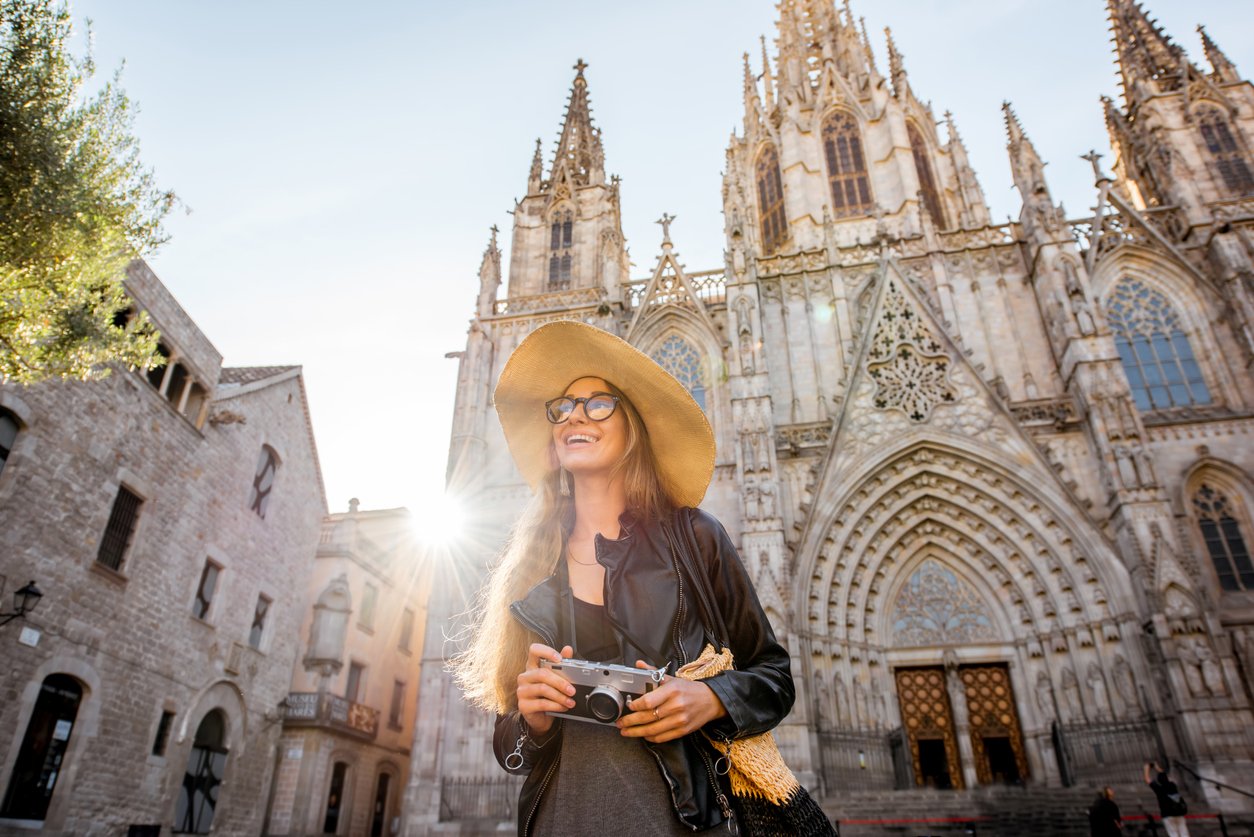
When you're traveling to Barcelona, the Gothic Cathedral of the Holy Cross and Saint Eulalia—simply known as Barcelona Cathedral—is an absolute must-see. This iconic monument is located in the Gothic Quarter. It is not just a place of worship but also a piece of living history.
The towering Gothic façade and the peaceful cloisters, where 13 white geese roam, are just some of the highlights. Every corner of the cathedral has a story to tell.
You don’t even need to be religious to enjoy this architectural wonder. With a mix of history, legends, art, and breathtaking views, Barcelona Cathedral is an experience that shouldn't be skipped.
So, if you’re planning a visit to Barcelona, this Gothic masterpiece deserves a top spot on your itinerary—and trust me, you’ll want to book your tickets in advance!
Save money on your trip to Barcelona!
With the Barcelona Essentials Pass you get:
Unlimited access to public transport
Free entrance to Park Güell and the Sagrada Familia
Audio guide for many attractions
10% discount on any other attraction
What is Barcelona Cathedral?
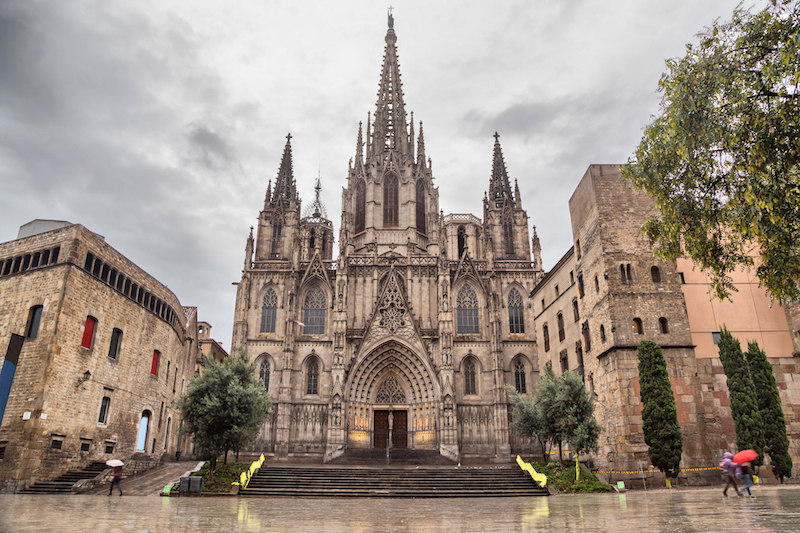
The Barcelona Cathedral is a Gothic-style masterpiece right in the heart of the city’s Gothic Quarter. This cathedral has been a center of faith and history since its construction began in the 13th century and is still a symbol of Barcelona's heritage today. Locals also refer to it as La Seu.
The cathedral is dedicated to Saint Eulalia, one of the city’s patron saints, who was martyred at the age of 13. Visitors can explore not just the interior’s towering arches and chapels, but also the crypt where her remains lie. The peaceful cloisters, home to 13 white geese, and the panoramic rooftop views are also highlights that shouldn’t be missed.
Although often confused with the Sagrada Familia, the Barcelona Cathedral has its own unique charm.
| Official Name | Cathedral of the Holy Cross and Saint Eulalia |
| Local Name | La Seu |
| Location | Gothic Quarter, Barcelona |
| Construction Period | 13th–15th century |
| Dedicated to | Saint Eulalia |
| Entry Fee | €14 (General), €6 (Under 12), Free (Under 3) |
| Vespertine Visit | €28 – Evening visit with terrace access |
| Combination Ticket | €47 – Includes access to other heritage sites |
| Group Entry | €8 per person (morning or afternoon, outside donation hours) |
| Free Entry Times | Mornings (before 1 PM) and afternoons (outside donation hours) |
| Lighting a Candle Online | €1 or €1.50 (Cathedral staff will light it for you) |
| Opening Hours | Mon-Fri: 9:30–18:30, Sat: 9:30–17:15, Sun: 14:00–17:00 |
| Metro Station | Jaume I (Line 4) |
| Highlight Features | Rooftop views, cloisters, crypt, gargoyles |
History of Barcelona Cathedral
The Barcelona Cathedral we see today began taking shape in 1298, but its story goes back even further. Before the Gothic structure, the site housed a Roman temple, and later, a paleo-Christian basilica in the 4th century. This early church was destroyed in 985 during a raid by Almanzor, ruler of the Cordoba Caliphate.
In 1046, a Romanesque cathedral was built, but as the city grew, it was replaced by the current Gothic masterpiece. Construction lasted from the 13th to 15th century, with the final touches added in 1448. The cathedral was dedicated to Saint Eulalia, a young martyr whose remains rest in the crypt beneath the high altar.
Though the main structure was completed in the 15th century, the ornate Neo-Gothic façade and central tower weren’t added until the 19th century. These elements gave the cathedral the striking look it has today, with 70-meter spires and a rooftop terrace offering spectacular views over the Gothic Quarter.
Even now, Barcelona Cathedral serves as a place of worship, history, and culture, hosting Masses, organ concerts, and events that connect the past with the present.
How to Get There
Barcelona Cathedral is easily accessible by public transportation, bike, or on foot.
By Metro
The nearest metro stations are:
Jaume I (Line 4 - Yellow Line): Just a 5-minute walk from the cathedral.
Liceu (Line 3 - Green Line): Around 8 minutes on foot, near La Rambla.
By Bus
Several buses stop near the cathedral:
V15, V17, 45, 120: Stop at Via Laietana – Pl Ramon Berenguer, about 3 minutes away.
N8, N28 (Night buses): Convenient for those visiting in the evening.
La Rambla – Liceu Stop: A 6-minute walk from the cathedral.
By Foot or a Bike
If you are exploring the Gothic Quarter or nearby attractions like La Rambla, the cathedral is easy to reach on foot. It’s located in Plaça de la Seu, right in the heart of the old city.
Barcelona is a bike-friendly city with extensive bike lanes. You can rent a bike from multiple locations around the city, including near the cathedral. Bike racks are available in the area, making it easy to park and explore.
Architectural Highlights – What to Look For
Barcelona Cathedral is a blend of Gothic elegance with touches of Neo-Gothic design. It is one of the most visually stunning landmarks in the city. The cathedral’s features are both grand and meaningful. Each element reflects centuries of craftsmanship, faith, and cultural influence.
Here are some of the most notable highlights you won’t want to miss during your visit.
The Gothic Façade and Towers
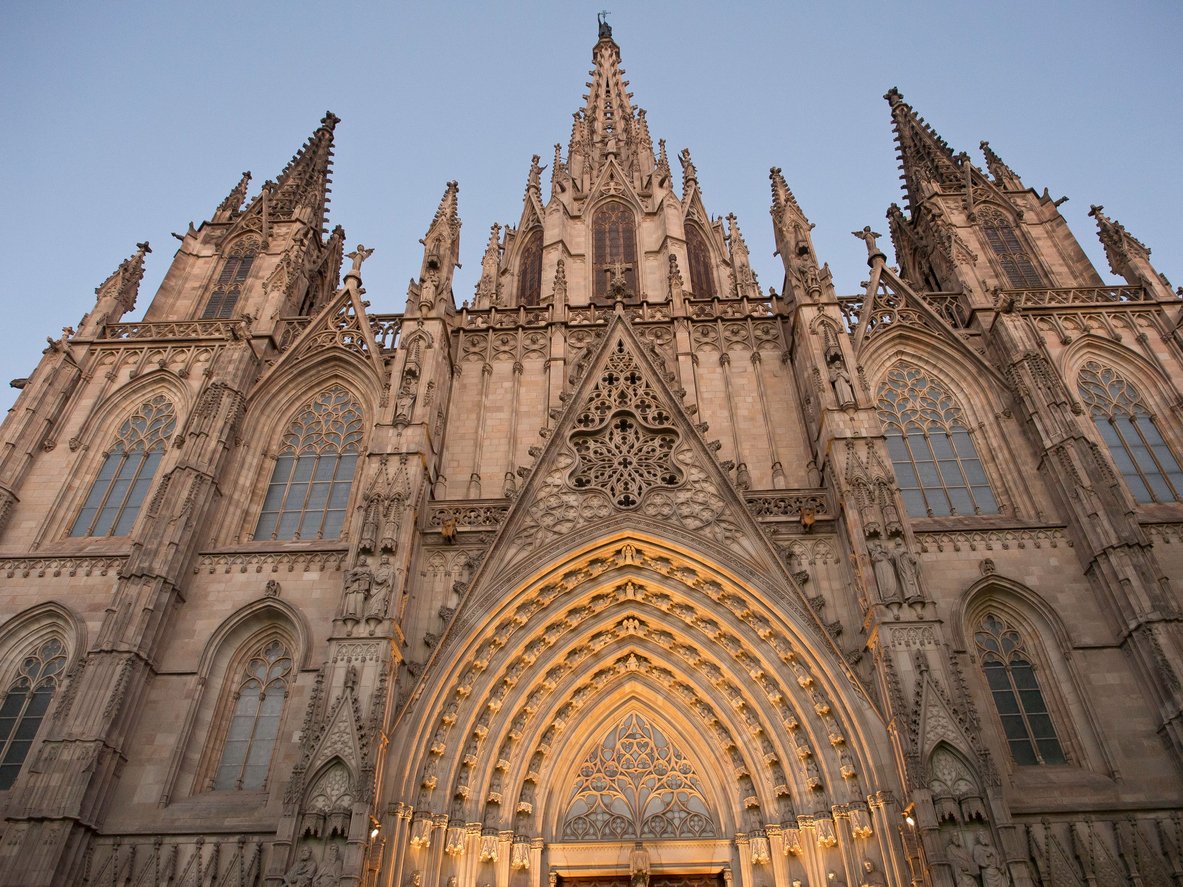
The façade of Barcelona Cathedral is a perfect example of Neo-Gothic design, though it was only added in the 19th century. Its sharp spires, elaborate carvings, and arched windows give the building an imposing yet elegant appearance. Rising to 70 meters, the central tower makes the cathedral one of the most striking sights in the Gothic Quarter.
Portal de Sant Iu – The Original Entrance
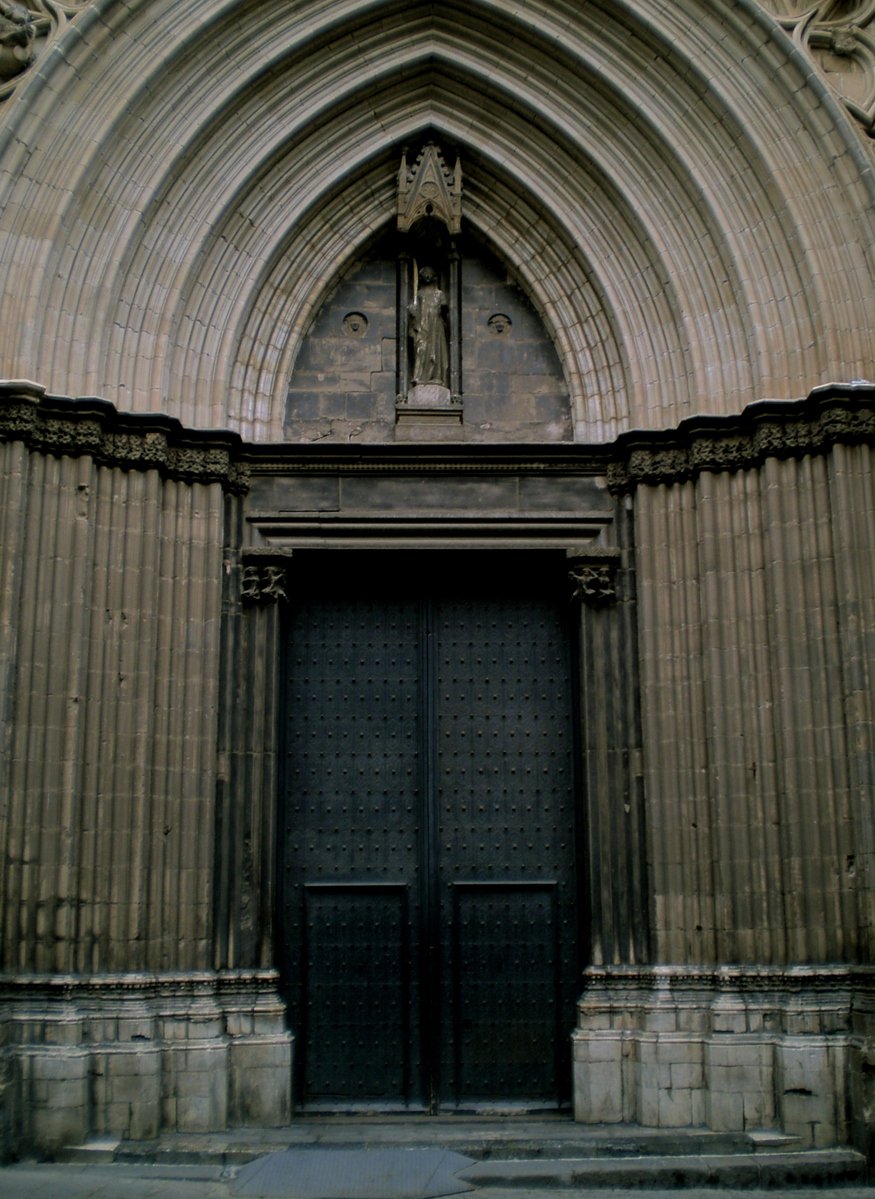
On the northeast side of the cathedral, the Portal de Sant Iu served as the main entrance for centuries. Built with marble and stone from Montjuïc, the portal is decorated with intricate carvings of knights, dragons, and mythical creatures. One carving supposedly depicts Wilfred the Hairy, the legendary founder of Catalonia.
Gargoyles – Guardians with a Purpose
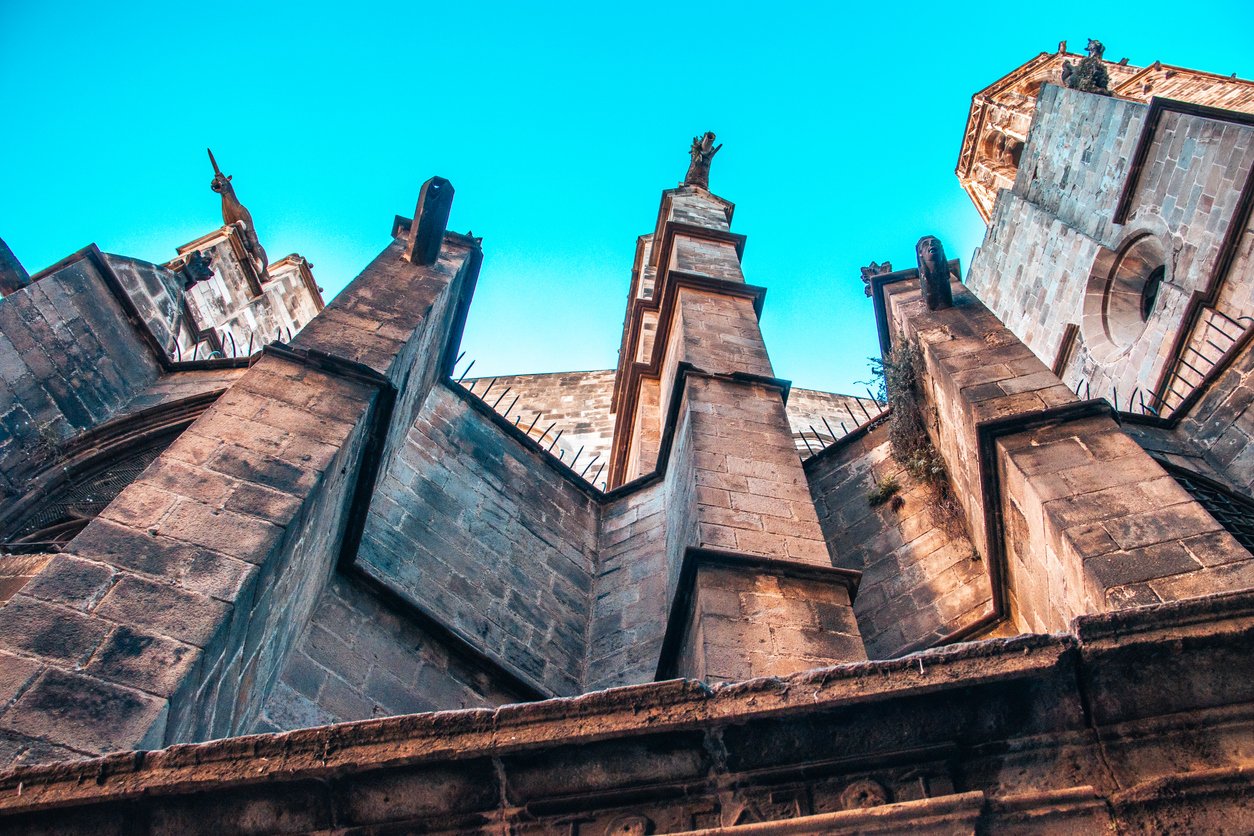
The cathedral is guarded by over 150 gargoyles, which serve both decorative and functional roles. These stone creatures are believed to ward off evil spirits, but they also act as rain gutters, channeling water away from the roof. Among the many gargoyles, a unicorn and a bull are two of the most famous, visible from Carrer de la Piedad.
The Choir Stalls and Nave
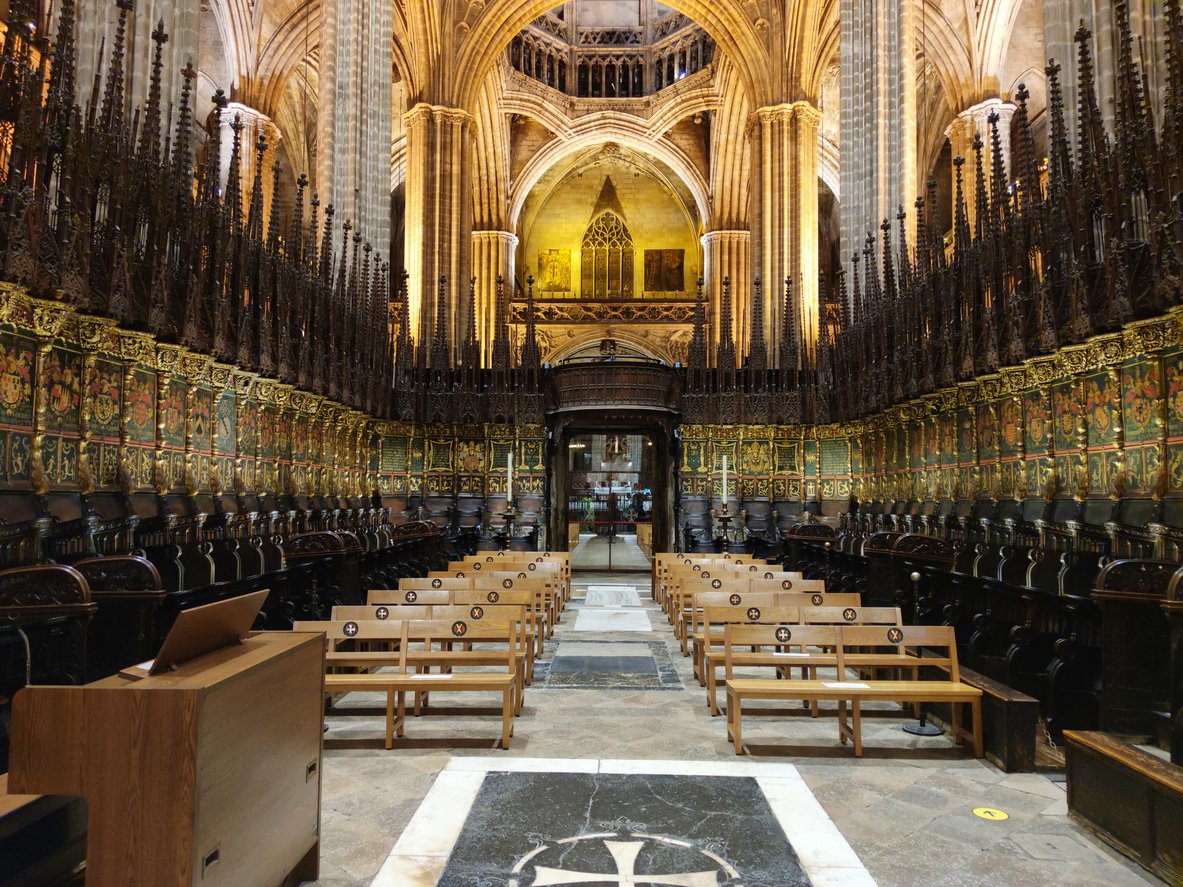
Inside the cathedral, the choir stalls are a highlight of Catalan Gothic sculpture. Completed in the 14th century, these intricately carved wooden seats were later adorned with coats of arms belonging to the Order of the Golden Fleece. Surrounding the choir, the nave is flanked by 26 side chapels, each dedicated to a different saint and illuminated by stunning stained glass windows.
The Crypt and Tomb of Saint Eulalia
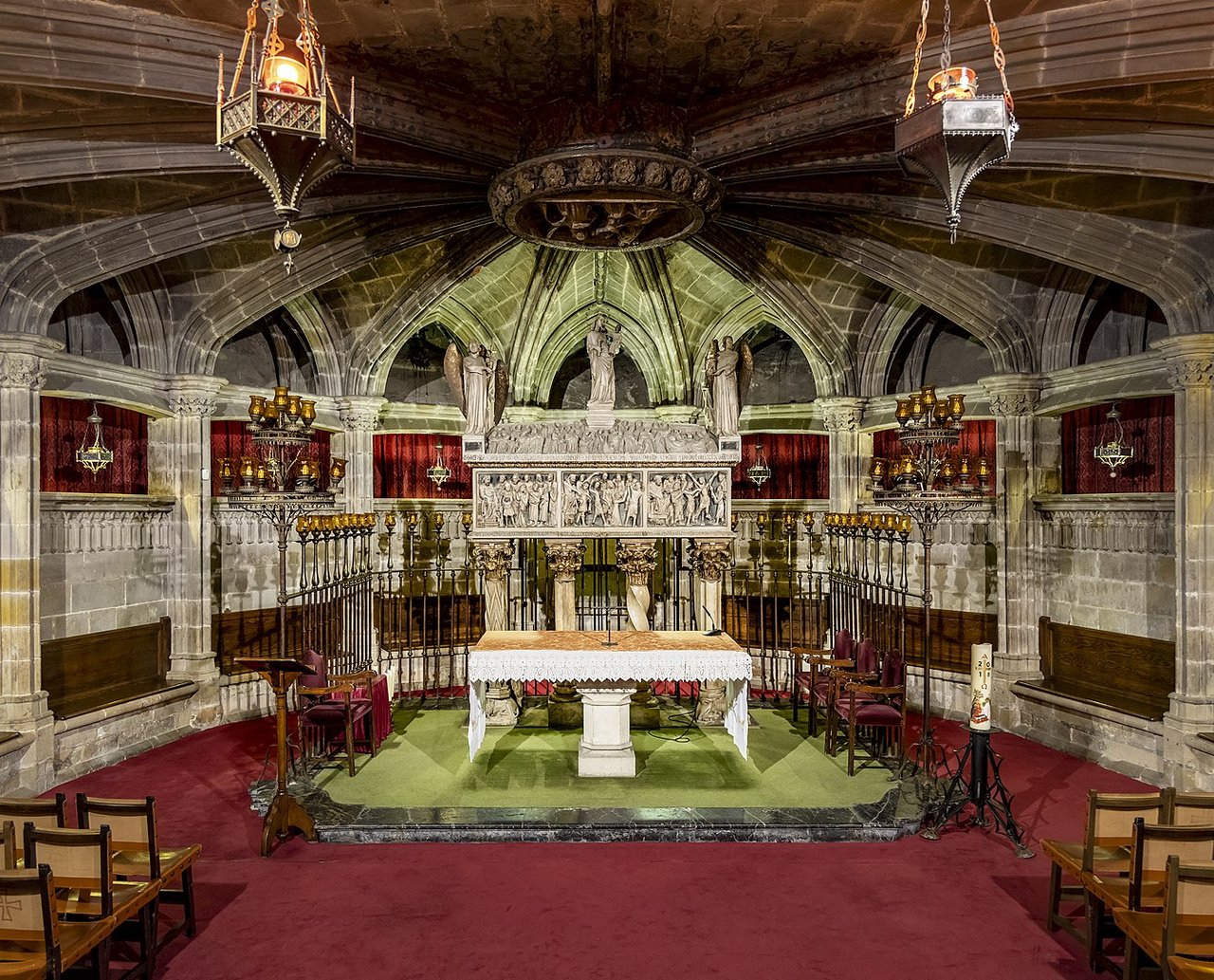
Photo by Didier Descouens, licensed under CC BY-SA 4.0.
Beneath the high altar lies the crypt of Saint Eulalia, a young martyr who is one of the city’s patron saints. Her stone sarcophagus, placed here in the 14th century, remains a sacred site for both locals and visitors. According to legend, Eulalia endured 13 tortures for refusing to denounce her Christian faith—one for each year of her short life.
The Cloisters and 13 White Geese
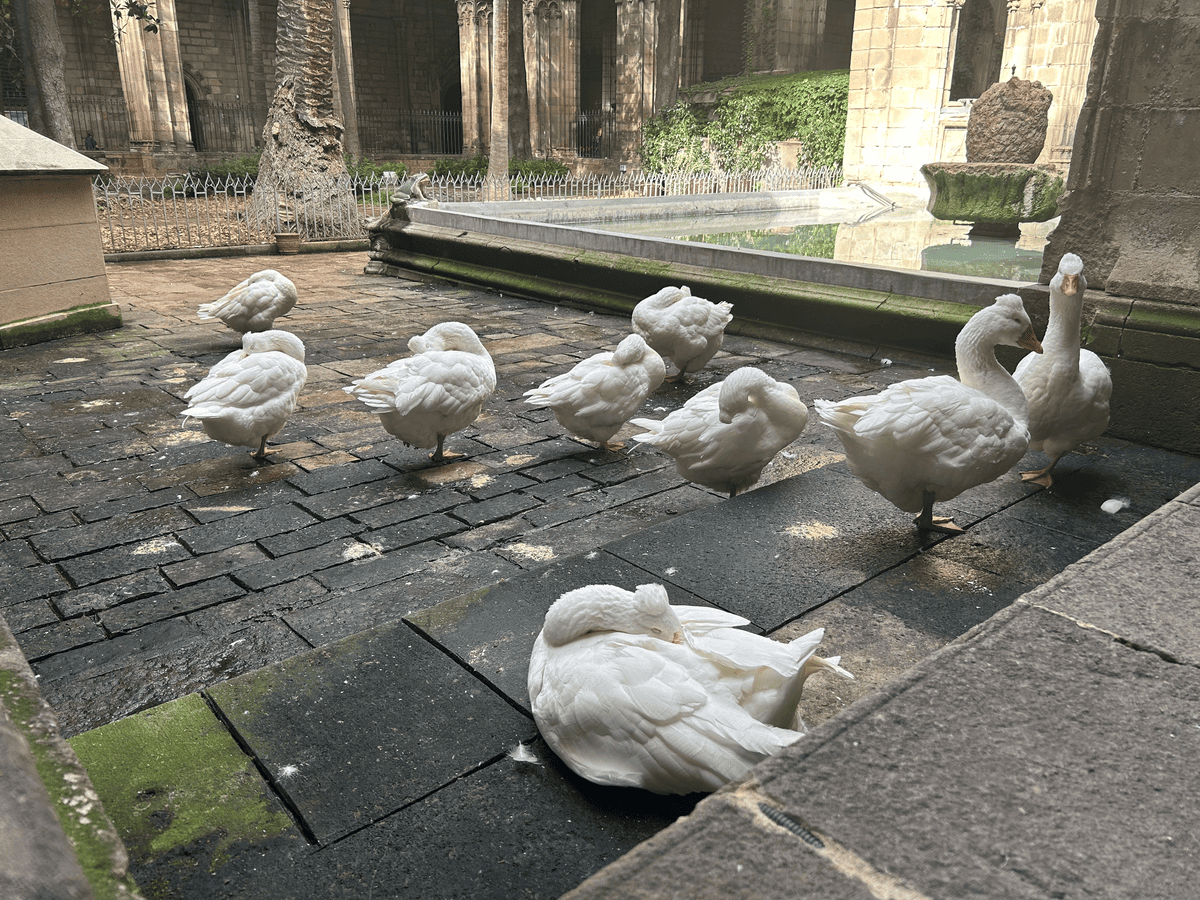
The cathedral’s cloisters, built in the 15th century, are a peaceful garden enclosed by Gothic arches. In the corner stands the Fountain of Sant Jordi, often decorated with flowers during local festivals. A unique feature of the cloister is the 13 white geese, said to symbolize the age of Saint Eulalia at her death. Their presence adds to the serene and symbolic atmosphere of the space.
The Rooftop Terrace and Panoramic Views
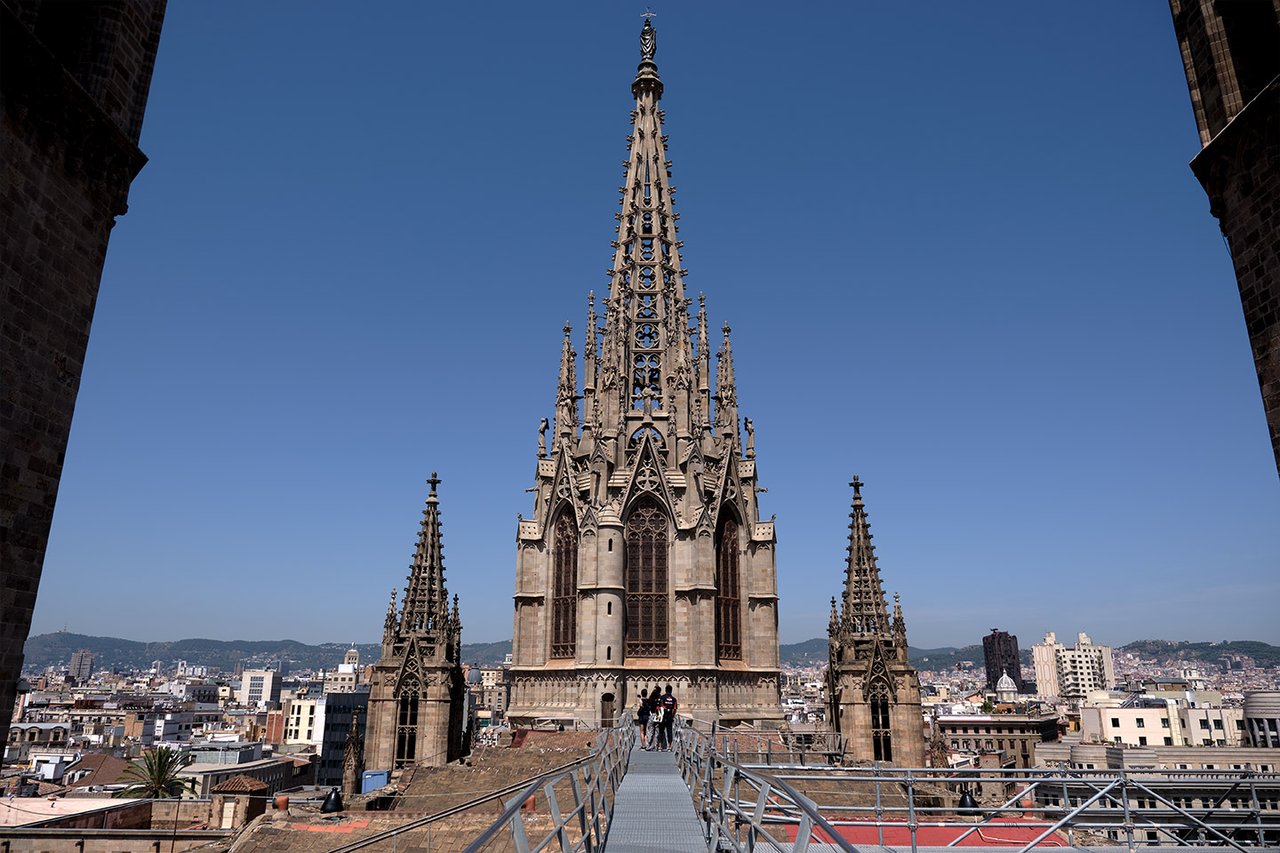
One of the most memorable experiences at the cathedral is climbing to the rooftop terrace. Accessible by elevator, the terrace offers 360º views of the Gothic Quarter and beyond. Visitors can admire the spires up close and take in Barcelona’s skyline, with medieval rooftops and modern cityscapes blending into one beautiful panorama.
Local Legends and Tales of Barcelona Cathedral
Beyond its beautiful architecture, Barcelona Cathedral is filled with fascinating legends that reflect the city’s culture and history. These legends are part of what makes Barcelona Cathedral more than just a place of worship. They connect the building to the city’s folklore, giving visitors a chance to experience local stories that have been passed down through generations.
The 13 White Geese of Saint Eulalia
One of the most well-known legends revolves around the 13 white geese that live in the cathedral’s cloister. The geese represent each year of Saint Eulalia’s life. According to legend, Eulalia, a young Christian martyr, was subjected to 13 tortures by Roman authorities for refusing to renounce her faith. Today, the geese serve as a tribute to her bravery and purity, making them a unique and symbolic part of the cathedral’s identity.
The Magical Turtle
Some visitors claim that a magical turtle is hidden within one of the cathedral’s fountains. Though difficult to spot, locals believe that finding it brings good luck. This quirky tale has become a fun challenge for observant visitors, adding a playful element to the cloister’s tranquil atmosphere.
El Cap Llarg – The Long-Headed Dragon
A curious dragon head, known as El Cap Llarg (Long Head), can be seen carved into one of the cathedral’s chapels. According to legend, this fearsome creature guarded the area and brought misfortune to anyone who dared oppose it. The dragon has since become a symbol of protection for the cathedral, warding off evil spirits.
Visiting Hours for Worship and Prayer
| Day | Morning Hours | Evening Hours |
|---|---|---|
| Monday - Friday | 8:30 AM - 12:30 PM | 5:45 PM - 7:30 PM |
| Saturday | 8:30 AM - 12:30 PM | 5:15 PM - 8:00 PM |
| Sunday | 8:30 AM - 1:45 PM | 5:15 PM - 8:00 PM |
Cultural and Tourist Visiting Hours
| Day | Visiting Hours | Last Entry |
|---|---|---|
| Monday - Friday | 10:30 AM – 6:30 PM | 6:00 PM |
| Saturday | 10:30 AM – 5:00 PM | 4:30 PM |
| Sunday | Closed for tourism | - |
Dress Code
As an active place of worship, the Barcelona Cathedral requires visitors to dress respectfully.
Cover your shoulders - No sleeveless shirts or tank tops.
Wear appropriate-length bottoms - Shorts, skirts, or dresses should fall at or below the knee.
Avoid beachwear or revealing clothing - No swimsuits or see-through outfits.
Comfortable but modest - Casual clothing is fine, as long as it is respectful.
Tips for an Unforgettable Visit
1. Book Your Tickets in Advance
Tickets to the cathedral can sell out quickly, especially during peak tourist seasons. Skip-the-line tickets or combination packages with other nearby attractions will save you time and hassle.
2. Arrive Early to Beat the Crowds
For the best experience, plan to visit early in the morning or late in the afternoon. This way, you can enjoy the cathedral’s beauty without large crowds, especially at the cloisters and rooftop terrace.
3. Bring Comfortable Shoes
The Gothic Quarter is best explored on foot, and you’ll be doing a fair amount of walking within the cathedral too. Wear comfortable shoes, especially if you plan to climb the rooftop terrace.
4. Take a Guided Tour or Use an Audio Guide
A guided tour or audio guide will enhance your visit by sharing the fascinating history and legends of the cathedral. Look for QR codes near the entrance to download the official audio guide.
5. Visit During a Service or Organ Concert
If you want to experience the spiritual side of the cathedral, attend a Mass or an organ concert. It’s a great way to feel the atmosphere and hear the acoustics of this grand space.
Nearby Attractions in the Gothic Quarter
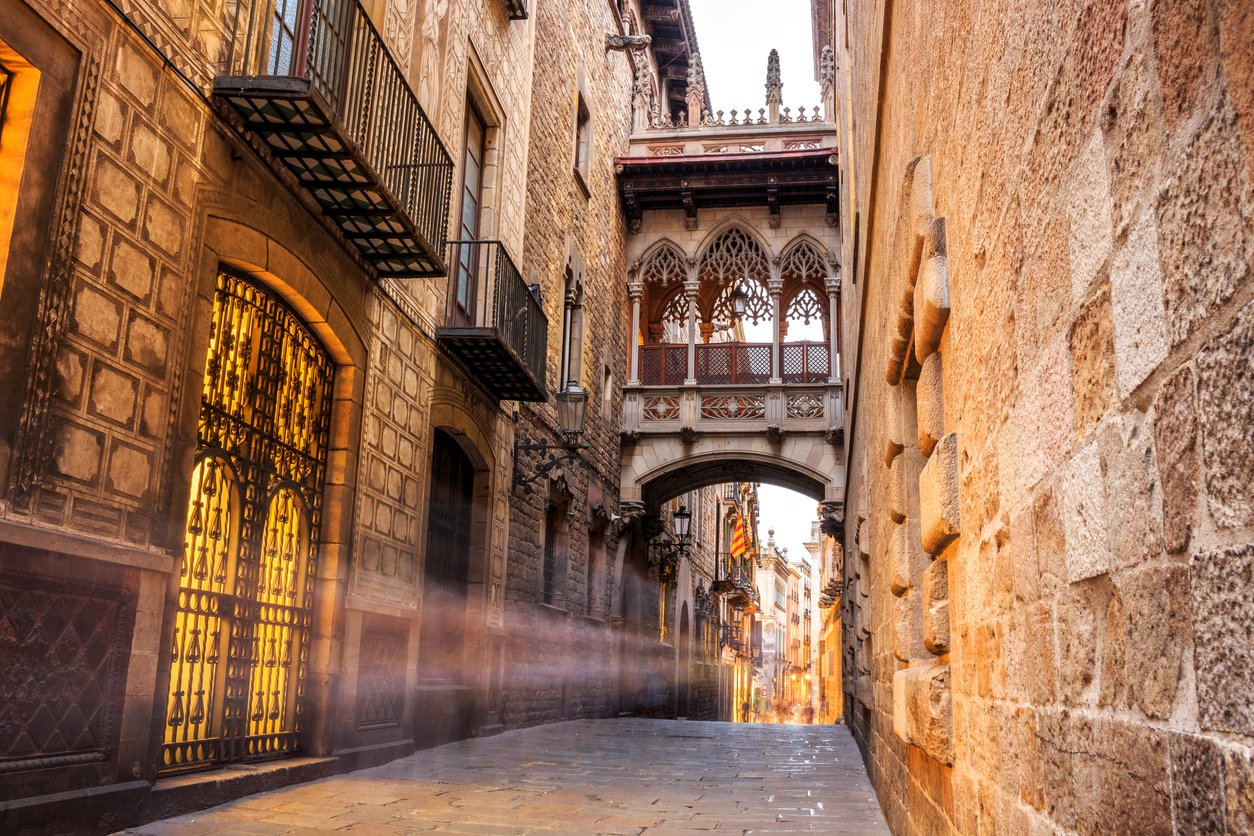
While visiting Barcelona Cathedral, take some time to explore these must-see spots within the charming Gothic Quarter.
Bishop’s Bridge (Pont del Bisbe)
A beautiful Neo-Gothic bridge, perfect for photos, just a short walk from the cathedral.
Plaça de Sant Felip Neri
A peaceful square with a tragic history, known for its moving Civil War memorial.
Picasso Museum
See over 4,000 works from the early years of Pablo Picasso, located nearby on Carrer Montcada.
El Call (Jewish Quarter)
Wander through narrow streets full of history, shops, and hidden gems.
Plaça Reial
A lively square filled with restaurants, cafés, and beautiful 19th-century architecture.
These attractions are all within walking distance of the cathedral.
Final Tips
The cathedral is a place of worship and history, so be mindful of your behavior:
No loud noise, littering, or flash photography inside.
Phones on silent mode to maintain a peaceful atmosphere for other visitors.
Photography is allowed in most areas, but be respectful of worshippers and signs where photos are prohibited.
Stop by nearby cafés or restaurants for a meal after your visit. Purchase souvenirs from local shops in the Gothic Quarter to take a piece of Barcelona home with you.
Some areas, like the rooftop terrace, may be closed during rain. It’s always good to check the forecast before planning your visit.
For more insider tips and guides about Barcelona, visit BarcaTrips. We cover everything you need to know—from the best attractions to hidden local spots and top dining experiences.
FAQs
Is Barcelona Cathedral accessible?
The cathedral provides elevator access to the rooftop terrace for those with limited mobility. Some areas, such as the cloisters, may have stairs, so plan accordingly if traveling with strollers or wheelchairs.
What is Barcelona Cathedral known for?
Barcelona Cathedral is renowned for its Gothic architecture, Neo-Gothic façade, and 70-meter spires. It is also known for the 13 white geese in the cloisters, symbolizing the age of Saint Eulalia at her death, as well as the crypt where her remains rest. Visitors also enjoy panoramic rooftop views and the beautiful choir stalls adorned with the coats of arms from the Knights of the Golden Fleece.
Who is buried in the Barcelona cathedral?
The remains of Saint Eulalia, one of the co-patron saints of Barcelona, rest in a sarcophagus inside the crypt beneath the high altar. Additionally, the tomb of Saint Olegarius, a bishop and significant religious figure, can also be found in the cathedral.
How long does a visit to Barcelona Cathedral take?
A visit to Barcelona Cathedral typically takes 1 to 2 hours. This gives you enough time to explore the interior chapels, the crypt, the cloisters, and rooftop terraces while also appreciating the façade and exterior features.
Is photography allowed inside of Barcelona Cathedral?
Yes, photography is allowed inside most areas of the cathedral. However, visitors are encouraged to avoid flash photography to respect the sacred space and protect the artwork. Some areas, such as the Chapter House, may prohibit photography, so it’s important to follow posted signs.
When is the best time to visit Barcelona Cathedral?
The best time to visit Barcelona Cathedral is on weekdays to avoid large weekend crowds. Early morning or late afternoon visits are ideal for a more peaceful experience.
In terms of season, the low seasons (November–March) have fewer tourists and shorter wait times, though the weather may be cooler or rainy. The peak season (June–August) provides warm weather but comes with larger crowds and longer queues.


